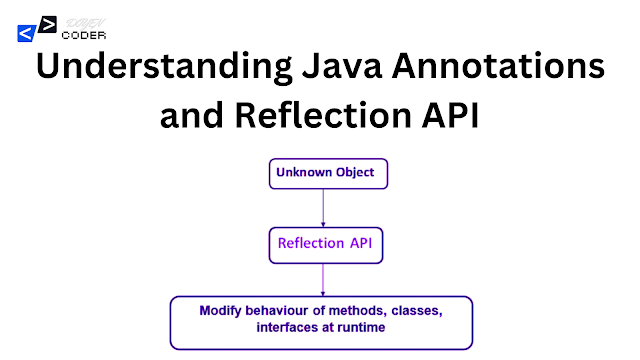Understanding Java Annotations and Reflection API
1. Introduction to Annotations
Annotations in Java are metadata that provide data about the code, but they are not part of the code itself. Annotations can be used to give instructions to the compiler, provide runtime information, and be processed by tools. Java provides several built-in annotations, and you can also define custom annotations.
2. Built-in Annotations
Java comes with a set of standard annotations like `@Override`, `@Deprecated`, and `@SuppressWarnings`. These annotations are typically used to signal intent to the compiler or developer.
class Parent { System.out.println("Parent display method"); }}
class Child extends Parent {
@Override
public void display() {
System.out.println("Child display method");
}
}
3. Custom Annotations
You can define your own annotations using the `@interface` keyword. Custom annotations are useful for creating your own metadata and can be processed at runtime using the Reflection API.
import java.lang.annotation.ElementType;import java.lang.annotation.RetentionPolicy;import java.lang.annotation.Target;
@Retention(RetentionPolicy.RUNTIME)
@Target(ElementType.METHOD)
public @interface MyAnnotation {
String value();
}
4. Introduction to the Reflection API
The Reflection API in Java allows for the inspection and manipulation of classes, methods, and fields at runtime. This can be useful for frameworks, libraries, and tools that need to work with code dynamically.
5. Using Reflection to Access Class Information
Reflection can be used to access information about a class, including its fields, methods, and constructors, even if they are private.
import java.lang.reflect.Method;
class ReflectionExample {
public void sayHello() {
System.out.println("Hello from Reflection!");
}
public static void main(String[] args) throws Exception {
ReflectionExample obj = new ReflectionExample();
Method method = obj.getClass().getMethod("sayHello");
method.invoke(obj);
}
}
6. Processing Annotations with Reflection
The Reflection API can be used to process annotations at runtime. This is especially useful in frameworks like Spring, which use annotations to inject dependencies, map routes, and more.
import java.lang.annotation.Annotation;
public class AnnotationProcessor {
@MyAnnotation(value = "Test annotation")
public void annotatedMethod() {
System.out.println("Annotated method executed.");
}
public static void main(String[] args) throws Exception {
AnnotationProcessor obj = new AnnotationProcessor();
Method method = obj.getClass().getMethod("annotatedMethod");
Annotation annotation = method.getAnnotation(MyAnnotation.class);
System.out.println(((MyAnnotation) annotation).value());
method.invoke(obj);
}
}7. Best Practices
While Reflection is a powerful tool, it comes with performance overhead and breaks type safety. Here are some best practices:
- Avoid overusing Reflection in performance-critical applications.
- Use annotations for configuration, but be cautious about excessive complexity in annotation processing.
- Combine annotations and Reflection wisely to create maintainable and flexible codebases.
8. Conclusion
Annotations and the Reflection API are essential tools for building flexible, reusable, and dynamic Java applications. By understanding how to create and process annotations, and how to use reflection effectively, you can build powerful frameworks, libraries, and applications.
Explanation of the Content
- Introduction to Annotations: Overview of Java annotations and their usage.
- Built-in Annotations: Examples of common annotations such as
@Overrideand@Deprecated. - Custom Annotations: Explanation of how to create custom annotations with an example.
- Reflection API: Introduction to the Java Reflection API and its purpose.
- Using Reflection: How to inspect and manipulate class information at runtime using reflection.
- Processing Annotations: Example of processing custom annotations using reflection.
- Best Practices: Tips on how to effectively use annotations and reflection without performance issues.
- Conclusion: Summary of the benefits of understanding annotations and the Reflection API.









0 Comments